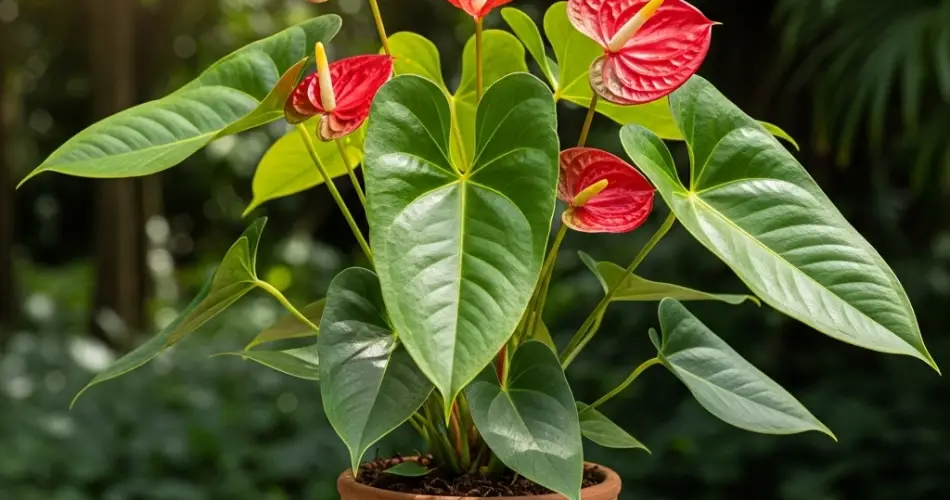Anthuriums are popular houseplants known for their glossy, heart-shaped leaves and vivid, long-lasting blooms. These tropical beauties are surprisingly easy to care for when grown in containers. However, like many potted plants, they benefit greatly from occasional repotting and consistent maintenance to stay healthy and attractive.
Knowing when and how to repot your anthurium is key to supporting strong root development, encouraging blooms, and preventing stress. Combined with regular care routines, repotting helps your anthurium thrive indoors all year round.
Why Repotting Is Necessary
Over time, the soil in a container becomes compacted and depleted of nutrients. Roots may also become pot-bound, circling around the base of the container with little room to expand. These conditions can lead to stunted growth, reduced flowering, and increased susceptibility to pests and diseases.
Repotting gives the plant access to fresh soil, improved drainage, and additional room for root growth. Most anthuriums benefit from being repotted every 1 to 2 years, though slower-growing varieties may only need it every 3 years.
When to Repot an Anthurium
The best time to repot an anthurium is during spring or early summer, when the plant is actively growing. This gives it time to recover and adjust to its new environment. However, if you notice signs of distress—such as roots protruding from drainage holes, water running straight through the soil, or slowed growth—it may be necessary to repot sooner.
Other signs it’s time to repot include:
-
The plant is top-heavy or unstable
-
Leaves are yellowing despite good care
-
Soil dries out very quickly or stays soggy
Choosing the Right Pot and Soil
When selecting a new container, choose one that is 1–2 inches larger in diameter than the current pot. Avoid oversized containers, which can hold excess moisture and increase the risk of root rot.
Drainage is critical. Always use a pot with one or more drainage holes to prevent soggy soil and promote airflow to the roots.
As for soil, anthuriums thrive in a well-draining, chunky mix. A good blend mimics the plant’s natural epiphytic habitat and may include:
-
1 part peat moss or coco coir
-
1 part perlite or pumice
-
1 part orchid bark
This combination retains some moisture but allows excellent airflow, reducing the risk of overwatering.
How to Repot an Anthurium Step-by-Step
1. Prepare Materials
Gather your new pot, fresh soil mix, gloves (optional), and a clean pair of pruning scissors.
2. Remove the Plant Gently
Slide the anthurium out of its current container by tipping the pot on its side and gently loosening the root ball. If the roots are stuck, tap the sides or squeeze a plastic pot to loosen it.
3. Inspect and Trim the Roots
Shake off old soil from the roots and inspect for any signs of rot, such as mushy or blackened roots. Trim these off using sterile scissors. If the roots are tightly circling, gently tease them apart to encourage outward growth.
4. Add Soil to the New Pot
Place a layer of fresh soil in the bottom of the new pot. Position the plant in the center so the crown sits just below the rim.
5. Fill Around the Plant
Backfill with the remaining soil mix, gently pressing it around the root ball to eliminate air pockets. Avoid compacting the soil too tightly, as this can reduce drainage.
6. Water Thoroughly
After repotting, water the plant well to help settle the soil. Allow any excess water to drain completely. Avoid fertilizing for a few weeks to allow the roots time to recover.
Ongoing Maintenance Tips
Light
Anthuriums prefer bright, indirect light. Keep them near a window with filtered sunlight or use sheer curtains to protect them from harsh rays. In low light, flowering may slow down.
Watering
Water when the top inch of soil feels dry. Be consistent but cautious—too much water can quickly lead to root rot. Reduce watering in the cooler months when growth slows.
Humidity
These tropical plants thrive in humidity levels between 60–80%. Mist the leaves, use a pebble tray, or run a humidifier nearby to maintain adequate moisture in the air.
Fertilizing
Feed your anthurium every 6–8 weeks during the growing season with a diluted, balanced liquid fertilizer. Use a formula that supports flowering for more vibrant and consistent blooms.
Cleaning and Pruning
Wipe the leaves occasionally with a damp cloth to remove dust. Trim any yellowing or dead leaves at the base using clean scissors to maintain the plant’s appearance and health.
Final Thoughts
Repotting an anthurium isn’t complicated, but doing it correctly makes a big difference in the plant’s long-term health. When paired with proper lighting, watering, and regular maintenance, a freshly repotted anthurium will continue to reward you with stunning foliage and bright flowers. Whether you’re a beginner or seasoned plant enthusiast, this low-maintenance plant brings tropical charm and vibrant energy to any indoor setting.



